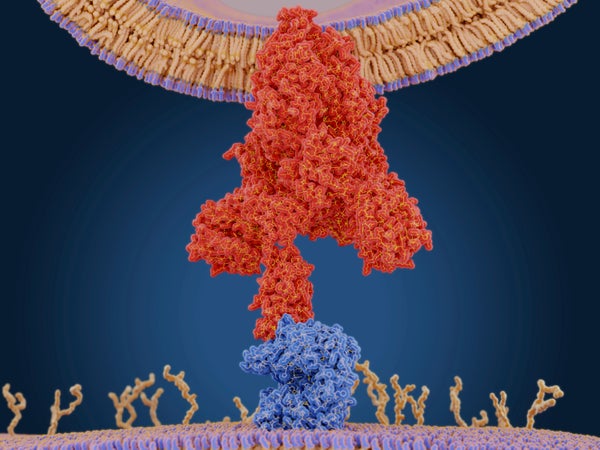When a virus invades your cells, it changes your body. But in the process, the pathogen changes its shape, too. A new mathematical model predicts the points on the virus that allow this shape-shifting to occur, revealing a new way to find potential drug and vaccine targets. The unique math-based approach has already identified potential targets in the coronavirus that causes COVID-19.
Outlined in April in the Journal of Computational Biology, the strategy predicts protein sites on viruses that stash energy—important spots that drugs could disable. In a rare feat, the work proceeds from pure mathematics, says study author and mathematician Robert Penner of the Institute of Advanced Scientific Studies in France. “There's precious little pure math in biology,” he adds. The paper’s predictions face a long road before they can be verified experimentally, says John Yin, who studies viruses at the University of Wisconsin–Madison and was not involved in the research. But he agrees that Penner’s approach has potential. “He’s coming at this from a mathematician’s point of view—but a very scientifically informed mathematician,” Yin says. “So that’s highly rare.”
Penner’s method takes advantage of the fact that certain viral proteins alter their shape dramatically when viruses breach cells, and this transformation depends on unstable features. (A stable protein site, by definition, resists change.) By identifying “high free energy sites”—areas on a viral protein that store lots of energy—Penner realized he could spot likely “spring” points that mediate this change in shape. He calls such high-energy spots exotic sites. Finding them required some complex math.
On supporting science journalism
If you're enjoying this article, consider supporting our award-winning journalism by subscribing. By purchasing a subscription you are helping to ensure the future of impactful stories about the discoveries and ideas shaping our world today.
Penner focused on the backbones of the proteins that undergo the most change during cell fusion and entry. He examined the hydrogen bonds that form between backbone sections when proteins fold. A protein consists of a series of individual units, or residues, with two such units forming hydrogen bonds. The bonded units rotate relative to each other, and those twists imply varying amounts of free energy in the residues involved.
To isolate the exotic rotations, Penner cranked a few mathematical levers on a giant collection of protein shapes. He and his colleagues had previously gathered a representative sample of proteins from a database and looked at the roughly 1.17 million backbone hydrogen bonds in the set. He then needed to establish how frequently different rotations appeared.
To find that information, Penner turned to geometry. In the 19th century, German mathematician Carl Friedrich Gauss showed that you can describe each unique rotation of three-dimensional space by specifying the axis around which that rotation turns and the amount by which it does so (picture a wheel turning around car axle by anywhere from zero to 360 degrees, or zero to two pi radians). You can represent each rotation with a vector, a measurement that has both a magnitude and a direction and that is usually pictured as an arrow of a certain length pointing in a specific direction. This arrow’s orientation describes the rotation’s axis, and the vector’s length gives the amount of rotation (imagine an axle that lengthens with further rotation). Collect all the vector arrows pointing out every which way from a central point, and you have all possible axes for a rotation to spin about. Spots along each axis (the arrow points of different vectors) identify all unique rotations: the possible amounts of rotation, from zero to two pi radians, around every axis.
Altogether these arrows make up a 3-D ball (imagine a spiny Koosh ball or a rolled-up hedgehog). This structure is what Penner wanted, because it allowed him to do some math on the points appearing in it. Penner mapped the rotations found in the database onto the ball. Then he calculated the frequency of each one by looking at the density of its surrounding region in the structure: rotations in less dense parts of the ball are rarer.
Scientists know that the frequency of a protein feature is related to a function of its free energy, such that rarer features have higher energies. So using established equations and the densities on the ball, Penner computed the free energy of different rotations, revealing exotic sites. One indication that the approach works is that it predicted already known functional sites, Penner says. But previously unknown sites discovered by this method could prove to be promising targets for drugs to attack.
If experiments verify Penner's predicted sites—a big if—the approach holds promise, says Arndt Benecke, a biological researcher at the French National Center for Scientific Research, who advises the mathematician. “If that were the case, then automatically, the free energy is something you could target that we’re not currently doing,” he says. “The whole thought of what could or should a drug or antibody do might change.”
In a follow-up study published in the same journal on Wednesday, Penner pinpointed three exotic “sites of interest” on the coronavirus behind COVID-19. But now theymust survive the rigors of the lab. Experimenters need to show that knocking out the sites indeed releases free energy, Benecke says. Even then, they may remain inaccessible to drugs, he adds. And any treatments targeting the sites must survive the usual tests for efficacy and safety in animal models and then in people. “The literature is littered with failures,” Penner says.
Still, if the method works, it could have applications for a wider range of targets, from the signaling proteins that allow cells to communicate with their environment to prions, the misfolded proteins behind conditions such as mad cow disease. “This could go far beyond the viruses,” Benecke says.
Read more about the coronavirus outbreak from Scientific American here. And read coverage from our international network of magazines here.
